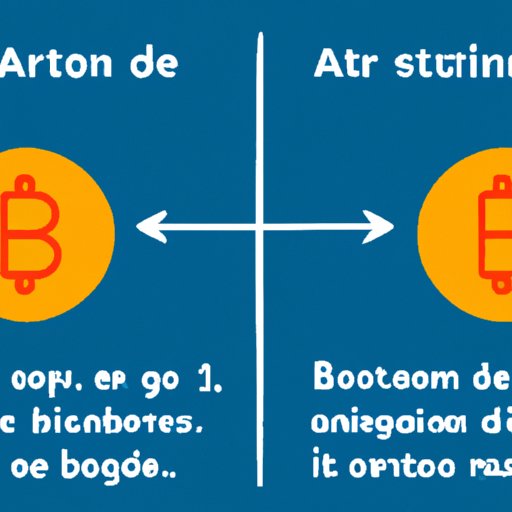Introduction
Bitcoin is a decentralized digital currency that was created in 2009. It operates without a central bank or single administrator, making it completely independent and global. Bitcoin transactions are recorded on a public ledger known as the blockchain, which is maintained by a network of computers.
This article will explain how to send bitcoins to an address. It will also provide examples of sending bitcoins using popular wallets, outline the benefits and potential risks associated with sending bitcoins, compare sending to an address vs. sending to another person, and offer advice on best practices.
Step-by-Step Guide for Sending Bitcoins to an Address
Sending bitcoins to an address is a simple process that can be done in a few steps. Here’s how to do it:
What is Needed to Send Bitcoins
In order to send bitcoins, you will need to have access to a wallet that stores your bitcoins. You will also need to know the recipient’s address, which is a long string of letters and numbers unique to their wallet. Finally, you will need to have enough funds in your wallet to cover the amount you are sending.
Setting Up a Wallet
The first step is to set up a wallet. This is where you store your bitcoins. There are many different types of wallets, including online, mobile, desktop, and hardware. Each type has its own advantages and disadvantages. Once you have chosen a wallet, you will need to create an account and fund it with bitcoins.
Accessing the Address
Once you have set up your wallet and funded it, you will need to access the recipient’s address. This can typically be done by copying and pasting it into the appropriate field in your wallet. Alternatively, you can scan a QR code associated with the address.
Sending the Money
Once you have accessed the recipient’s address, you can enter the amount of bitcoins you want to send. Be sure to double check the address and amount before confirming the transaction. Once you have confirmed the transaction, the funds will be sent to the recipient’s wallet. Depending on the network, it may take a few minutes for the transaction to be completed.
Examples of Sending Bitcoins to an Address Using Popular Wallets
There are many different types of wallets available, but some of the most popular ones include Coinbase and Blockchain. Here’s how to send bitcoins using these wallets:
Coinbase
Coinbase is an online wallet that allows users to buy, sell, and store cryptocurrencies. To send bitcoins using Coinbase, log in to your account and select “Send” from the top menu. Enter the recipient’s address and the amount of bitcoins you want to send. Once you have reviewed the details, click “Send Now” to complete the transaction.
Blockchain
Blockchain is a popular mobile wallet that allows users to store, buy, and sell cryptocurrencies. To send bitcoins using Blockchain, open the app and select “Send” from the home screen. Enter the recipient’s address and the amount of bitcoins you want to send. Once you have reviewed the details, click “Send” to complete the transaction.
Benefits of Sending Bitcoins to an Address
Sending bitcoins to an address has several benefits, including increased security, low fees, and fast transactions. Here’s a closer look at each of these benefits:
Increased Security
One of the main benefits of sending bitcoins to an address is that it is much more secure than other methods of payment. All transactions are encrypted and stored on the blockchain, making them virtually impossible to hack. Furthermore, all transactions are irreversible, so once the money has been sent, it cannot be reversed.
Low Fees
Another benefit of sending bitcoins to an address is that it is much cheaper than other forms of payment. Most transactions have very low fees, sometimes even free. This makes it an attractive option for those who need to send large amounts of money quickly and cheaply.
Fast Transactions
Finally, sending bitcoins to an address is much faster than other forms of payment. Transactions are typically completed within minutes, making it a great option for those who need to send money quickly.

Potential Risks Associated with Sending Bitcoins to an Address
While there are many benefits to sending bitcoins to an address, there are also potential risks associated with it. These include scams, hacking, and lack of regulation. Here’s a closer look at each of these risks:
Scams
One of the biggest risks associated with sending bitcoins to an address is the risk of being scammed. Scammers can use fake addresses to trick you into sending them money. Therefore, it is important to always make sure you are sending money to the correct address.
Hacking
Another risk associated with sending bitcoins to an address is the risk of being hacked. Although the blockchain is secure, hackers can still gain access to your wallet if they have your login credentials. Therefore, it is important to always use strong passwords and enable two-factor authentication whenever possible.
Lack of Regulation
Finally, there is the risk of lack of regulation. Unlike traditional currencies, there is no government or central bank regulating the value of bitcoins. This means that prices can fluctuate drastically, making it difficult to predict when to buy or sell.

Comparing Sending Bitcoins to an Address vs. Sending to Another Person
When it comes to sending bitcoins, there are two main options: sending to an address or sending to another person. Here’s a comparison of the two methods:
Differences in Process
The main difference between sending bitcoins to an address and sending to another person is the process. When sending to an address, you will need to access the recipient’s address and enter the amount of bitcoins you want to send. When sending to another person, you will need to enter their email address or phone number and the amount of bitcoins you want to send.
Different Levels of Security
Another difference between the two methods is the level of security. When sending to an address, you can rest assured that the transaction is secure because it is stored on the blockchain. However, when sending to another person, there is no guarantee that the transaction will be secure because it is not stored on the blockchain.

Advice on Best Practices for Sending Bitcoins to an Address
To ensure safe and successful transactions, it is important to follow best practices when sending bitcoins to an address. Here are some tips to keep in mind:
Verifying the Recipient’s Identity
When sending bitcoins to an address, it is important to verify the recipient’s identity. This can be done by asking them to provide proof of their identity, such as a driver’s license or passport. This will help protect you from being scammed.
Double Checking the Address
It is also important to double check the address before sending the money. Mistyping the address or entering the wrong one can result in the money being sent to the wrong person. Therefore, it is important to always double check the address before confirming the transaction.
Keeping Records of the Transaction
Finally, it is important to keep records of the transaction. This can be done by taking screenshots of the transaction or saving the transaction details in a spreadsheet. Keeping records of the transaction will help you keep track of your funds and ensure that everything goes smoothly.
Conclusion
Sending bitcoins to an address is a simple process that can be done in a few steps. There are many benefits to sending bitcoins to an address, including increased security, low fees, and fast transactions. However, there are also potential risks associated with it, such as scams, hacking, and lack of regulation. It is important to follow best practices when sending bitcoins to an address, such as verifying the recipient’s identity, double checking the address, and keeping records of the transaction.
In conclusion, sending bitcoins to an address is a quick and easy way to send money. With the right precautions, sending bitcoins can be a safe and secure way to transfer funds.
(Note: Is this article not meeting your expectations? Do you have knowledge or insights to share? Unlock new opportunities and expand your reach by joining our authors team. Click Registration to join us and share your expertise with our readers.)
